Co-Scholastic Activities
- Home
- Curriculum

Co-Scholastic Activities
Scholastic and co-scholastic activities complement each other and develop all rounded, socially skilled and healthier students. The co-scholastic activities such as music, keyboard, dance and yoga classes are conducted regularly. Basic keyboard symbols, major and minor scales, patriotic and devotional songs are taught to children. Classical and western dances are introduced to coordinate the different parts of the body like hands, eyes, fingers, feet,etc. to express in a natural way of human feelings and expressions.

BAND
A school band is a group of student musicians who rehearse and perform instrumental music together. A concert band is usually under the direction of one or more conductors (band directors). A musical ensemble associated with a school, not necessarily a musical school; eg marching band. A list of names of musical instruments in English: accordion; acoustic guitar; bagpipes; banjo; bass guitar; bongo drums; bugle; cello ...

YOGA
Yoga, an effective art of healthy living can be a game-changer for a student. Yoga helps the students to unite the physical, mental and spiritual aspects of the body. If a student practices yoga regularly, they will have a positive effect on both their health and academics.

CLASSICAL DANCE
Classical dance is a performance art used for both education and performance. It has evolved from early dance forms used in religious ceremonies and celebrations. Classical dance is a basic form of art because it is rooted in classical ballet and opera. Classical dance has many benefits, including:
Physical Fitness
Classical dance can improve your overall fitness, cardiovascular health, balance, and coordination. It can also help you move more efficiently, which may lead to weight loss.
Mental Health
Classical dance can help ease tension and stress, improve your mood, and promote relaxation. It can also help keep your mind sharp, improve your self-esteem, and reduce loneliness and anxiety.
Cognitive Benefits
Classical dance can help improve your memory and concentration. For example, Kathak requires you to master complex rhythms and sequences, which requires significant mental effort and concentration.
Creative Expression
Classical dance can be a form of creative expression. For example, Kathak is an art of storytelling through movement.

WESTERN DANCE
Western Dance can refer to many different dance styles, often associated with western music and western traditions. Some examples of western dance forms include hip-hop break dancing, ballet, salsa. Western dance in schools can help children develop creativity, imagination and critical thinking skills. The can also help children build trust and effective relationship. It can also help reduce stress and depression, improve flexibility and boost energy. In our school commercial western dance only teach to the students choreogher also well trained to teach this dance. It is very useful in the future for our students.
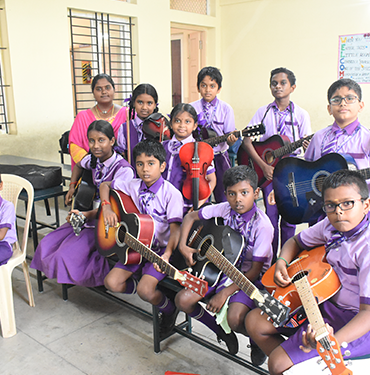
MUSIC
Students feel a sense of belonging when they listen to music. Music encourages them to stay focused and increase their self-confidence. Musical training helps to develop language and reasoning. Both music and singing have positive impact on all aspects of childhood learning and development. Research has already shown the importance of music in education including students’ academic success.
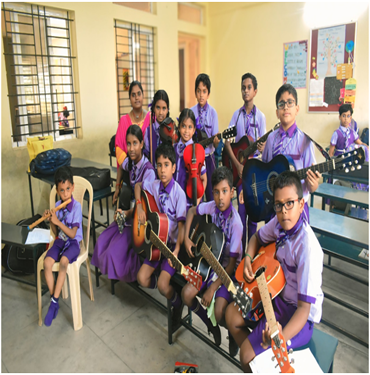
MUSICAL INSTRUMENTS
Musical instrument, any device for producing a musical sound. The principal types of such instruments, classified by the method of producing sound, are percussion, stringed, keyboard, wind, and electronic.
Bone whistle, c. 10,000 BC; in the Pitt-Rivers Museum, Oxford, Eng. Musical instruments are almost universal components of human culture: archaeology has revealed pipes and whistles in the Paleolithic Period and clay drums and shell trumpets in the Neolithic Period.
It has been firmly established that the ancient city cultures of Mesopotamia, the Mediterranean, India, East Asia, and the Americas all possessed diverse and well-developed assortments of musical instruments, indicating that a long previous development must have existed. As to the origin of musical instruments, however, there can be only conjecture. Some scholars have speculated that the first instruments were derived from such utilitarian objects as cooking pots (drums) and hunting bows (musical bows); others have argued that instruments
of music might well have preceded pots and bows; while in the myths of cultures throughout the world the origin of music has frequently been attributed to the gods, especially in areas where music seems to have been regarded as an essential component of the ritual believed necessary for spiritual survival.
The sound produced by an instrument can be affected by many factors, including the material from which the instrument is made, its size and shape, and the way that it is played. For example, a stringed instrument may be struck, plucked, or bowed, each method producing a distinctive sound. A wooden instrument struck by a beater sounds markedly different from a metal instrument, even if the two instruments are otherwise identical. On the other hand, a flute made of metal does not produce a substantially different sound from one made of wood, for in this case the vibrations are in the column of air in the instrument. The characteristic timbre of wind instruments depends on other factors, notably the length and shape of the tube. The length of the tube not only determines the pitch but also affects the timbre: the piccolo, being half the size of the flute, has a shriller sound. The shape of the tube determines the presence or absence of the “upper partials” (harmonic or nonharmonic overtones), which give colour to the single note. (For more on the science of sound, see acoustics.)
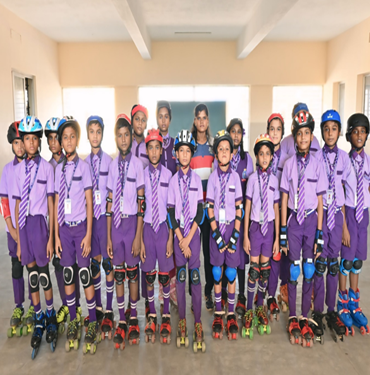
SKATING
To get through something difficult with ease. Jeff finds this stuff easy, so he just skates by at work.To get through something difficult with ease. Jeff finds this stuff easy, so he just skates by at work.
Cardiovascular Health
Skating increases heart rate and blood flow, which can strengthen heart and lungs.
Muscle Toning
Skating works out muscles in core, legs, and glutes, which can help you tone and improve your stamina.
Stress Relief
Skating releases endorphins, which can help reduce stress, anxiety, and depression.
Improved Balance And Coordination
Skating helps improve your balance and coordination by strengthening core and lower back muscles.
Low Impact
Skating is a low-impact sport, which means it's easier on joints than other high-impact sports like running.
Agility
Skating can help improve agility, motor skills, and posture.
Weight Management
Skating can help you burn calories, which can help you lose or maintain weight.
Mental Health
Skating can boost self-confidence and enhance mood.
Improved Joint Flexibility
Gliding on ice requires synchronized movement of legs, which can improve joint flexibility.
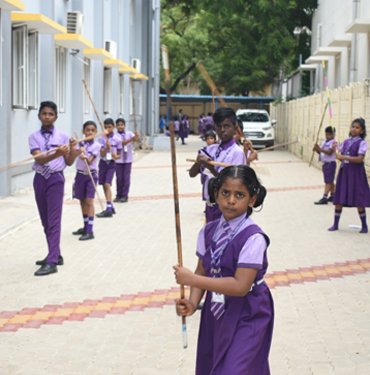
SILAMBAM
Silambam is a good form of cardio workout that improves blood circulation and heart function. Burns calories, helps in weight reduction and shaping of body. Relieves mental stress, laziness and fatigue. Improves body flexibility and reflexive movement of joints and muscles. Silambam is an old Indian martial art originating in the southern Indian state of Tamil Nadu. This style is mentioned in Tamil Sangam literature. It is said that the play of Silambam would promote strength, increase appetite, remove diseases due to phlegm and wind, and eliminate Constipation and colic.

TAEKWONDO
Taekwondo comes from three Korean words, tae, "kick," kwon, "fist or punch," and do, "the art of." That's a pretty good description of this dynamic martial art, which involves acrobatic kicks and graceful punches. Like all martial arts, taekwondo isn't just combat — it's also an art and a discipline.
Taekwondo has many benefits, including:
Physical health
Taekwondo can improve your physical condition, including your strength, stamina, flexibility, balance, posture, agility, and reflexes. It can also strengthen your arms, legs, back, and chest.
Mental health
Taekwondo can help improve your confidence, self-esteem, focus, and selfdiscipline. It can also help reduce stress.
Self-defense
Taekwondo can teach you quick and precise striking techniques to help you defend yourself. It can also help you assess threats and maintain advantageous positioning.
Leadership skills
Taekwondo can help you develop leadership abilities, such as communication, mental endurance, and integrity.
Respect
Taekwondo emphasizes respect, and students are expected to use "ma'am" and "sir" when addressing their elders.
Social interaction
Taekwondo can help you grow your social circle by providing you with the opportunity to interact with disciplined and respectful peers.
Learning something new
Taekwondo can be a good way to challenge yourself and acquire new skills, which can be good for your mind and body.
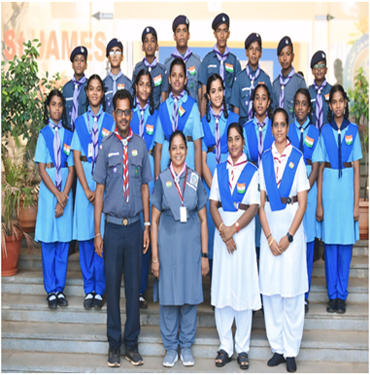
THE BHARAT SCOUTS & GUIDES
It is the moment of the youth and the programme for the youth has been designed in such a way that our youth may take interest in it and enjoy Scouting and Guiding. We started this moment in our school in the year 2016 as BulBul and Cubs. From 2017 we added Scouts and Guides. Since 2022 we have been sending students for Rajyapuraskar award ( Governor’s award).
The Activities Done During 2024 Are
- Maintaining the cleanliness of the campus.
- Fireless cooking
- Making temporary Tents
- Basic first Aid
They are Abdul Kalam and Baden Powel – Scout.
Mother Teresa and Agnes - Guides.
Awards :
- In the year 2022 8 Scout and 5 Guides received the Rajyapuraskar award.
- In the year 2023 8 Scout and 5 Guides received the Rajyapuraskar award.
- This year 8 Scout and 4 Guides are preparing to appear for the exam to get the award.
- Since 2017 our students have been attending many camps conducted by the District Bharath Scout and Guide in the centre at Kattur.
- We the mastero and captains along with scouts and guides take part in all the programmes conducted by the District and State Government.

JRC (JUNIOR RED CROSS)
- Protection of life and heath.
- Learning and practicing first aid.
- Learning and practicing home nursing.
- Learning how to prevent accidents.
- Blood donation and donor recruitment.
The Junior Red Cross (JRC) is the youth branch of the Red Cross Society, an international humanitarian organization. The JRC's mission is to promote the Red Cross's principles and values, and to encourage young people to participate in community service and social welfare activities. The Junior Red Cross was established in 1922 in the hope of encouraging younger generations to cultivate their humanitarian spirit.
First aid training:
Learn how to provide basic medical care to an injured or sick person until professional help arrives.
Volunteering:
Help the Red Cross serve the vulnerable and needy.
Blood donation camps:
Organize blood donation camps and raise awareness about the importance of safe blood donation.
Health promotion:
Promote health and life, and conduct awareness programs on diseases like HIV/AIDS.
Health camps:
Participate in health camps where you can learn activities and share your Red Cross experiences .
Youth exchange programs:
Visit international camps and participate in youth exchange programs.

SPORTS ACTIVITIES
There are lots of games played at the school level but the most common and important games coaching are offered for Cricket, Foot ball, Tennis, Badminton, Basket Ball and much more. Skills like teamwork, leadership, patience, discipline, learning from failure, sportsmanship etc. are developed only when children play sports regularly, and these are equally important when it comes to studies and sports activities. Sports activities helps in building skills and students have a great career in sports.
Sports Coaching After School Hours
Our physical education teachers give special coaching for the interested students in Athletics, Football, Cricket, Volley Ball, Throw Ball, Throw events and Kho-Kho from 04.00 to 05.00 pm.

CHESS
Every week two days students are practicing chess with the guidance of trained instructor who ensure quality coaching to our students. This helps students to build confidence and provides them with rewarding challenges. To make the programme effective, the students participating in friendly matches and also chess competition conducted outside the campus. Chess class as an extracurricular activity in school is a fantastic way to foster critical thinking, problem – solving and strategic planning skills in students. Chess teaches patience, concentration and sportsmanship making it an excellent addition to any school programme.
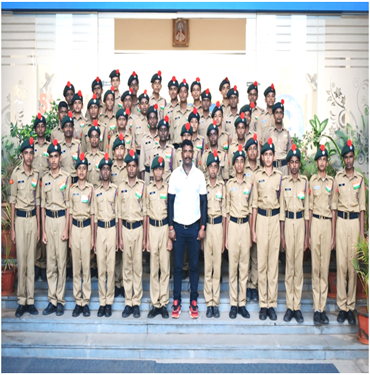
NATIONAL CADET CORPS
NATIONAL CADET CORPS National Cadet Corps (NCC) National Cadet Corps is a Tri-Services Organisation comprising the Army, Navy and Air Force, engaged in grooming the youth – 'The Leaders of Tomorrow' – into disciplined and patriotic citizens.
National Cadet Corps (NCC) clubs offer a variety of activities, including:
Military Training
Drill exercises, weapon handling, map reading, physical fitness training, and leadership development activities.
Adventure ActivtiesS
Mountaineering expeditions, trekking, parasailing, sailing, scuba diving, kayaking, and camel safaris.
Community Development
Planting tree saplings, adult education, blood donation, Earth Day awareness campaign, anti dowry pledge, eye donation, health education, shramdaan, and assistance in disaster management.
Other Acivities
Unarmed combat (UAC), first aid, hygiene and sanitation, civil defense, organization and administration of NCC, field engineering, camp craft, ecology, and leadership traits. NCC activities aim to instill discipline, teamwork, and self-confidence among cadets. To create human resource of organized, trained and motivated youth, provide leadership in all walks of life including the Armed Forces and always be available for the service of the Nation. The final decision for selection of “Unity and Discipline” as motto for the NCC was taken in the 12th CAC meeting held on 12 Oct 1980.
Camp Training
Cadets learn to live in a regimented way, and develop teamwork, leadership, and self-confidence. Cadets also apply their theoretical knowledge in practical situations.
